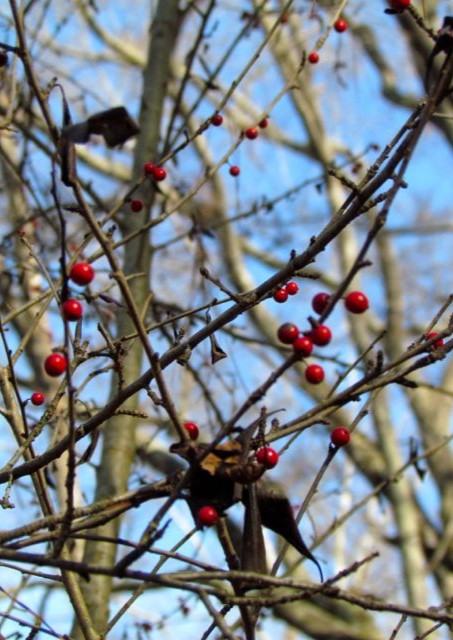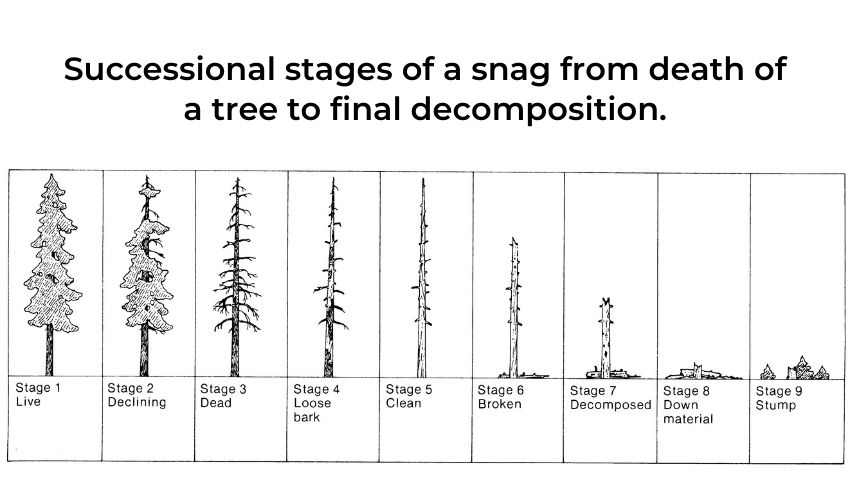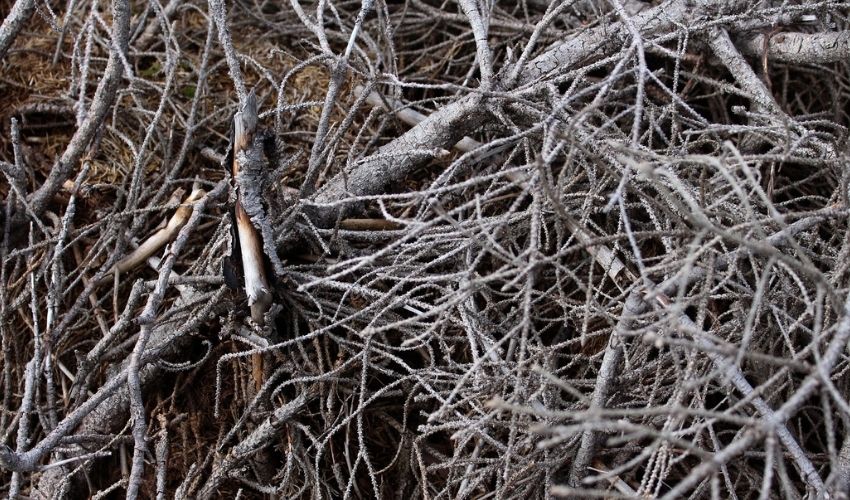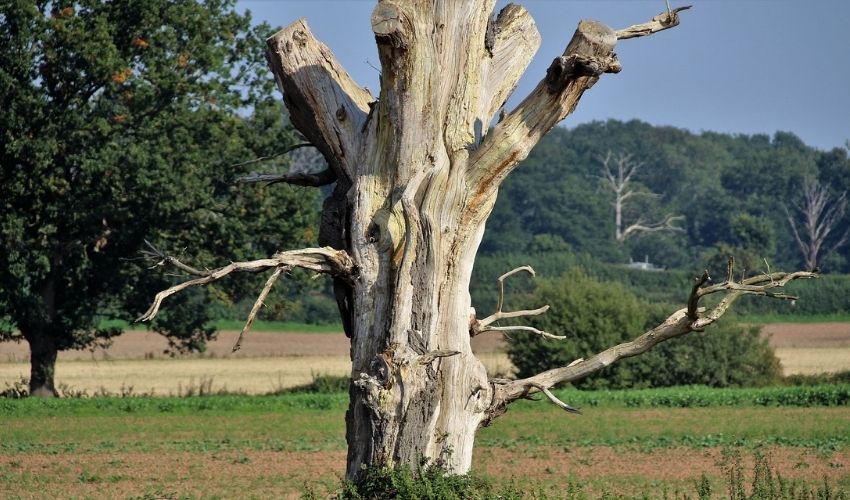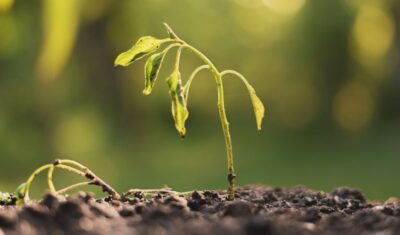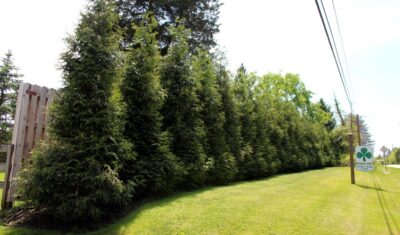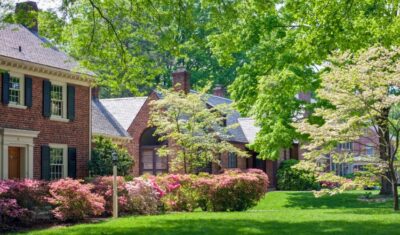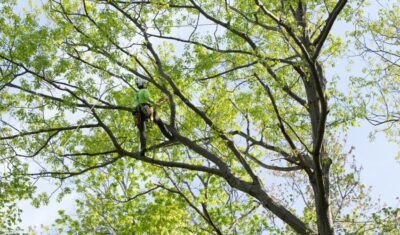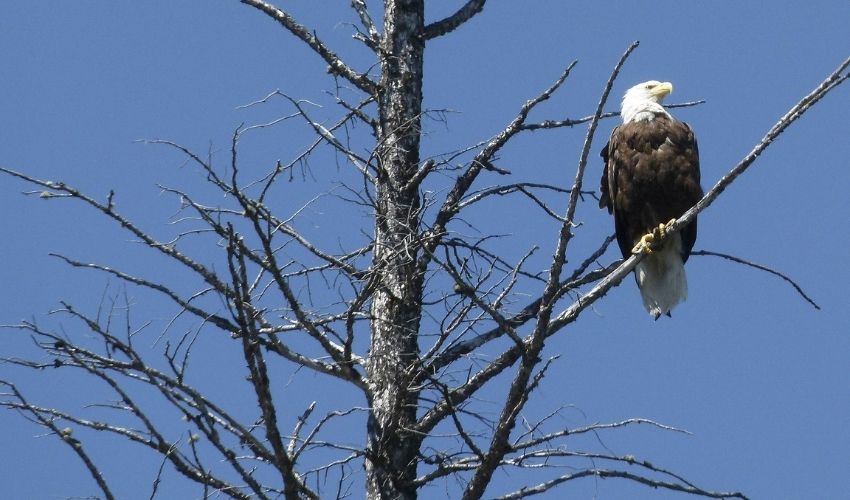
While there are many cases where a dead tree should be removed from a property for safety, health, or aesthetic purposes, in some cases, it may be better to simply leave it alone.
In this article, we discuss:
- ways that dead trees, called snags, can benefit wildlife,
- what to do if you have a dead or dying tree,
- safety considerations,
- choosing a tree to use for wildlife habitat,
- how to turn a tree into a snag, and
- how to decide what is right for your property.
We also cover other ways that you can provide benefits for local wildlife in your own yard.
When To Remove a Dead or Dying Tree
First, let’s cover when you absolutely should have a tree removed from your property.
If your tree died from Emerald Ash Borer (EAB)
Ash trees that have been infested with Emerald Ash Borer become brittle, dry, and very unstable. Removal of these trees is dangerous but leaving the tree standing is even more dangerous. Limbs can break off and fall, injuring any people, buildings, or property below. The entire tree is in danger of toppling and, once the borers are done with that tree, they will move on to the next one.
It’s essential to remove any ash tree that has been harmed by EAB. But, given the hazards associated with dead ash trees, they should only be removed by professional arborists with the training and equipment to deal with them safely.
If your neighborhood or HOA does not allow dead trees
You may want to consider other options that will allow you to support local wildlife and build soil health while staying within your community’s guidelines.
If the tree poses a safety risk
While EAB-infested trees are the most dangerous because of their brittle state, other infested trees may need to be removed to ensure they don’t spread pest problems to other trees. Diseased trees, as well, may need to be removed for the same reason.
A dead tree that is in danger of falling or breaking, has been damaged by storms, shows signs of root rot or severe root damage, or that is near powerlines or buildings should also be removed.
Now that we’ve covered the reasons to remove a dead tree, let’s talk about some reasons you may want to keep it.
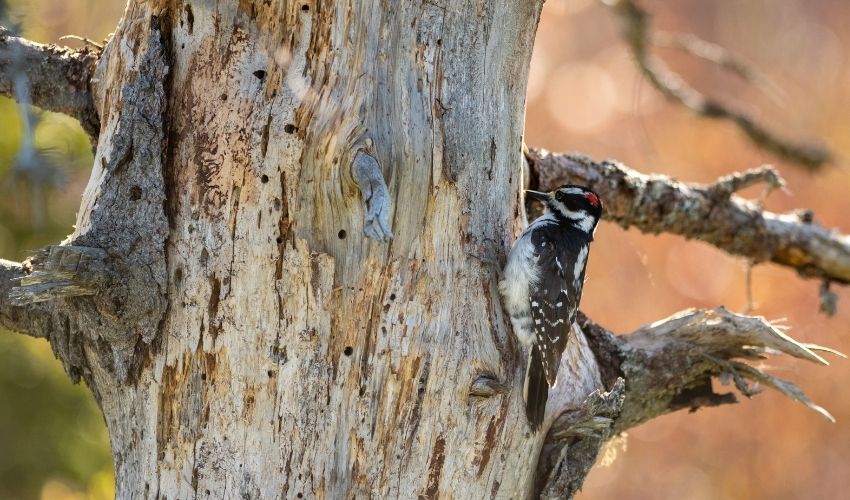
Hairy woodpeckers are among the many species of birds that rely on dead trees for food and shelter.
How Dead Trees Can Help Your Ecosystem
Dead trees left upright to decompose naturally are referred to as “snags” and are an important part of the natural world. They can become:
- a home for a wide range of animals,
- a nurse for young seedlings,
- a place for fungi to grow,
- a shelter for passing wildlife,
- a nesting place,
- a perch, and
- much more.
Snags Are Vital for Wildlife
There are at least 80 species of birds and more than 100 animals of all kinds that rely on dead trees for nesting, storing food, hunting, and perching. Woodpeckers, in particular, rely on snags for food. The deadwood often contains a variety of insects, which woodpeckers eat after chipping away at the wood to reach them.
While woodpeckers create holes, there are many other types of birds that don’t create cavities but use them for nesting or shelter, such as owls. Even bees,important for pollination, often use snags for their eggs.
The Washington Department of Fish and Wildlife has fascinating PDFs about dead trees where you can learn more about the importance of snags in your neighborhood.
Bats may use snags if there is a slit for them to roost. The higher up on a snag they are, the more likely that bats will use them. Some songbirds may use the slits for roosting purposes as well.
PRO TIP: Most trees will not naturally have these slits, but you can create them with a chainsaw. The slits should be 8 or more inches deep, at least one inch wide, and angled sharply upward. Ensure that no branches are in the way and that the tree is big enough to handle the cuts needed.
Snags Enrich the Surrounding Soil
As the tree decays, the soil around it will become much richer, thanks to the organic compounds it naturally adds to the ground. As we’ve mentioned before, the lack of naturally-occurring nutrients is why most trees in urban and suburban settings need fertilizer to remain healthy.
Learn more about why soil health matters >>
Tree Species that Make the Best Snags
Different types of trees offer different benefits as snags – some are tall and provide great perches, especially for birds of prey. Others are better at developing cavities, and smaller trees work well for smaller animals and insects.
Large conifer trees will probably stay standing longer than large deciduous trees, as they rot more slowly. These include:
- Cedar (Western red cedar is a favorite of many creatures)
- Fir (Douglas fir works well)
- Larch
- Pine
Some deciduous trees may rot more quickly, so they will decompose into the soil at a faster rate:
- Alder
- Birch
- Cherry
Large deciduous trees tend to last for a long time, and often have cavities while they are still alive. Good options include:
- Cottonwood
- Big-leaf maples
- Oaks
Softwood trees are generally better as food foraging sites, while hardwood is often used for nesting. However, almost any kind of tree will provide benefits as a snag to wildlife.
How to Choose a Tree to Create a Snag
The reality is that you’re not likely to plant a tree just so you can kill it and turn it into a snag! A better way to create this type of wildlife benefit on your property is to examine the trees that you already have. If a tree is already dead, it may be a good candidate. Otherwise, look for signs that the tree is dying, such as:
- Trees that have sap running out of them
- Tree trunks that have a large crack or split through them
- Main limbs that are dead or dying
- Fungi on the bark
- Woodpecker holes or other evidence of animal activity
- Forked tops of trees
NOTE: Not all of the signs above mean that your tree is facing certain death! Consult with a Certified Arborist to learn what’s going on with your tree and whether it can be saved. Often, we can recommend treatments, corrective pruning, or safety measures to protect the tree.
Alternatively, you may decide to turn an unwanted tree into a snag, rather than removing it entirely. For example, you could choose:
- Messy trees (with an excessive number of seed pods, for example)
- Trees with invasive roots near buildings, pipes, or walkways
- Trees that need shade but are growing in full sun (or vice versa)
- A shade tree in an area that you would like to be sunny
- Trees that are growing too close together (you can choose one to be a snag tree)
Turning a Dead Tree into a Snag
Just because a tree is dead (or dying) doesn’t mean you have a good wildlife tree. There’s still work to be done to ensure that the tree is safe and that it stays that way for as long as possible. Call in a tree care professional for a consultation on the best way to turn your tree into a wildlife habitat.
Turning a tree into a snag is usually done by a climber who ascends the tree or an arborist working from a bucket truck. The work could include:
- Removing some of the branches, leaving stubs and shortened branches whenever possible
- Cutting down the tree to 1/3 to 2/3 of its original height to reduce the risk of it hitting something if it falls (even a 10-foot snag can provide valuable habitat for many different animals)
- Installing cabling or bracing to hold the tree trunk together (if needed)
- Creating cavities for shelter and nesting
- Roughing up the top of the cut tree with a chainsaw or ax to allow water to infiltrate and get the decay process started more quickly
Any material that’s removed from the tree can be repurposed. Save the branches and use them to create a brush pile.
Logs and Brush Piles
Logs and brush piles are still valuable for wildlife. The pile of sticks and twigs can provide shelter for smaller animals, and protection from the elements (such as rain, snow, and sun) and predators. Songbirds often use the brush as a place to perch, and the decaying branches attract insects, a valuable food source for many types of wildlife.
Logs work much the same way – they provide shelter for small or medium-sized wildlife, can become a food source (fungi often grow on dead logs, which is a form of sustenance for some animals), and is a resting spot.
Other Ways to Support Wildlife
If you don’t have a way to keep a snag, log, or branch pile in your yard, don’t despair! There are other ways to create an ecosystem on your property.
Living Trees
Trees that are alive and thriving benefit the local critters too! They provide perches for birds, nesting sites for various creatures, seeds or nuts for food, and leaves to provide shade during a hot day.
Some homeowners choose to keep dead branches on trees if they are not in danger of falling or causing damage. These dead branches provide many of the same benefits as snags, including naturally occurring hollow spaces for foraging, perching, nesting, and storing food.
Shrubs with Winter Berries
Birds rely primarily on insects for food during the winter, which is why snags are important for their survival. However, another way to provide food during the winter months is to choose shrubs and trees with winter berries.
The berries not only are a great food source for birds, but they also add a bright pop of color to your landscape during months that are often cloudy and drab. As you can see in the pictures, the shrubs look especially festive when covered with snow.
Recommended shrubs and trees with winter berries include:
- Hollies
- Chokeberries
- Spicebush
- Staghorm sumac
- Inkberry
- Vibernum
- American elder (elderberries)
- Bayberries
- Crabapple
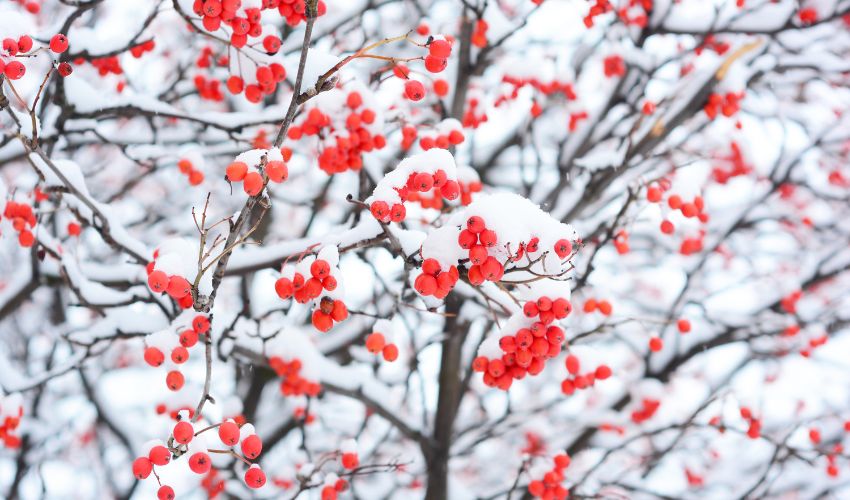
Bright red crab apples covered in snow provide a vital winter food source for wildlife while adding vibrant color to the cold landscape.
More Options for Dead or Dying Trees
There may be a time when you have a dying tree that has meant a lot to you, but you don’t want to turn it into a snag. Luckily, you have a few other options.
One is to contract a local artist and turn the dead tree into a work of art. A quick internet search will show dead trees that have been turned into bears, totem poles, tree houses – even free libraries or pantries for the neighborhood.
Another option is to create something from the wood of the tree. Not all trees have wood that is useful for projects, but many can be used to create tables, chairs, benches, boxes, or other wood products. In fact, Independent Tree may be able to help you with a furniture project, so contact us for more information.
Removed trees can also be turned into firewood for your fireplace or outdoor fire pit, continuing to give benefits to your house.
In Summary
The good news is, a tree’s value and purpose do not die along with the tree. As you’ve hopefully realized, trees continue to give back to the world around them even after they have stopped growing or producing leaves or needles, flowers, seeds, or fruit.
If you’d like assistance in transforming your property into a wildlife-friendly ecosystem, contact Independent Tree. We can help you decide the best and safest way to create a snag, where to place a brush pile, which wildlife-friendly shrubs to plant, or if removal is the best option.
Contact Independent Tree
Our professional tree care experts can help you remove excess branches from a dead tree to create a snag. We can also remove trees that are too dangerous to keep on your property, help you choose other trees to plant, and more!Recent Articles
Topics
About The Author

STAY IN THE LOOP
WITH OUR
LATEST UPDATES
"*" indicates required fields

